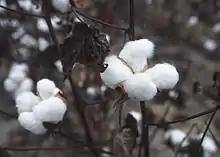Better Cotton Initiative
The Better Cotton Initiative (BCI) is a non-profit, multistakeholder governance group that promotes better standards in cotton farming and practices across 21 countries. As of 2017, Better Cotton accounts for 14% of global cotton production. In the 2016-2017 cotton season, 1.3 million licensed BCI Farmers produced 3.3 million metric tonnes of Better Cotton lint, enabling a record-level of more sustainably produced cotton to enter the global supply chain.[1] Partner retailers include H&M, Gap, IKEA, and Levi Strauss, and include funding partners from USAID.[2] At the end of 2017, BCI had 1,197 members – 85 retailer and brand members, 1,039 supplier and manufacturer members, 32 producer organisation members, 31 civil society members and 12 associate members.[3] BCI meets UN's goals to achieve better global water sustainability and sustainable agriculture.[4]
| Abbreviation | BCI |
|---|---|
| Formation | 2005 (as Better Cotton Initiative)a |
| Purpose | |
Region | Worldwide |
| Website |
BCI Farmers receive training on how to use water efficiently, care for the health of the soil and natural habitats, minimise the impact of harmful crop protection practices, preserve fibre quality and apply decent work principles.[5] BCI also promotes use of better irrigation practices with farmers, as well as reducing the use of fertilizers. Some examples point to a 40% reduction in water use by farmers in Pakistan and farmers in India cutting water use by half.[6]

Some similar conservation efforts for cotton farming practices include Bayer's CropScience’s e3 sustainable cotton program.[7]
History
The Better Cotton Initiative started in a roundtable discussion by the World Wildlife Fund (WWF) in 2005. It exists to make global cotton production better for the people who produce it, better for the environment it grows in and better for the sector’s future.[8] Implementation of practices began in 2010 including regions and countries in Africa, as well as Brazil, India, and Pakistan. The initiative expanded to several other new countries in 2013 including China, Tajikistan, Turkey, and Mozambique.[9]
Levi Strauss has released figures that donations to BCI between 2009 and 2011 were approximately $600,000.[7]
Labor practices
Better Cotton Initiative advertises that it encourages fair work practices and reduction of child labor in countries such as India by raising public awareness.[10] The company has also worked with an independent consultancy, Ergon Associates in 2012 in a study to create formal policies, training partnerships, and research on farmer incomes, safety, and labor.[11] In 2018 Terre des hommes Foundation (Tdh), the leading Swiss organisation for children’s aid, partnered with the Better Cotton Initiative to support cotton farmers, to address and prevent the risks of child labour and to promote decent work in cotton farming.[12]
Partners may use unannounced spot checks for work environments and conduct worker interviews to assess levels of child labor and bonded labor. The International Resources for Fairer Trade (IRFT) also organizes training sessions for work environments and topics on agronomics.[11]
Criticism
Recently, independent studies and journalistic investigations sought to demonstrate that the Better Cotton Initiative was offering greenwashing solutions to firms or intermediate producers that are systematically resorting to child labour, forced labour, intensive irrigation or massive pesticide spraying.[13] They have accused the Better Cotton Initiative of providing a marketable 'one-size-fits-all' consumer label to clothing firms that does not offer any information or guarantee in terms of social and environmental responsibility. [14] The Better Cotton Initiative responded to these allegations as an unjustified representation of its activity.[15]
References
- "BCI inches closer to mainstreaming Better Cotton". 2018-07-06. Retrieved 2018-07-23.
- "Better Cotton Initiative". Better Cotton Initiative. Retrieved 2017-04-16.
- "Around 350 brands support BCI's Cotton Sustainability - Clean Future". Clean Future. 2018-04-14. Retrieved 2018-07-23.
- "Better Cotton Initiative (BCI)". supply-chain.unglobalcompact.org. Retrieved 2017-04-16.
- "Mango commits to sustainable cotton sourcing". 2018-04-19. Retrieved 2018-08-15.
- Confino, Jo (2011-12-09). "Can the Better Cotton Initiative transform the global textile industry?". The Guardian. ISSN 0261-3077. Retrieved 2017-04-16.
- "Why Retailers Like Zara and Ikea Are Turning to Sustainable Cotton". Bloomberg.com. 2016-10-20. Retrieved 2017-04-16.
- "Better Cotton Initiative benefits sector". Solidaridad Network. 2014-08-21. Retrieved 2018-08-15.
- "BCI History - Better Cotton Initiative". Better Cotton Initiative. Retrieved 2017-04-16.
- "Can going green help pick the slavery out of cotton?". Reuters. 2017-02-10. Retrieved 2017-04-16.
- "Promoting decent work in cotton: GOOD PRACTICE AND GUIDANCE FOR BCI IMPLEMENTING PARTNERS" (PDF). Oct 2013. Retrieved 2016-04-26.
- "Terre des hommes | La plus grande organisation suisse d'aide à l'enfance". www.tdh.ch (in French). Retrieved 2018-08-16.
- "Cash Investigation". Cash Investigation (in French). Retrieved 2017-11-30. (France 2 official channel)
- "BCI and the greening of cotton". Wageningen University & Research. Retrieved 2017-11-30.
- Guinebault, FashionNetwork.com, Matthieu. "Coton : épinglée par Cash Investigation, la Better Cotton Initiative répond". FashionNetwork.com (in French). Retrieved 2018-08-15.